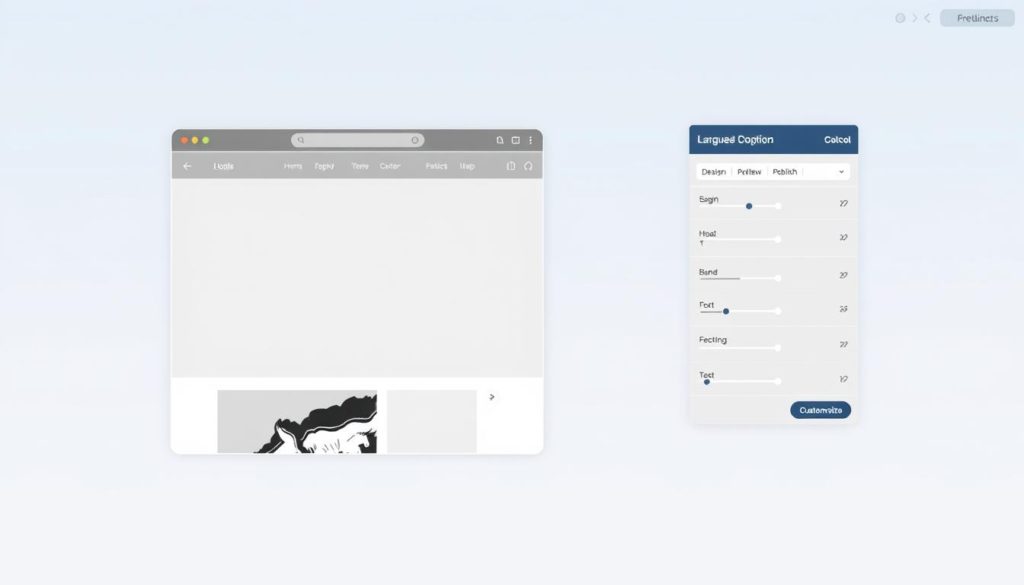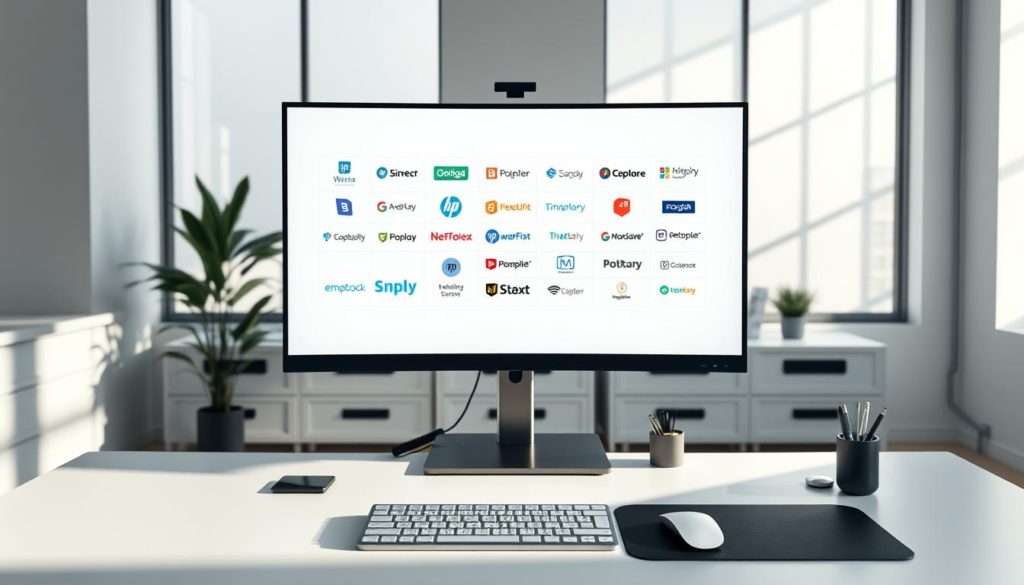
What if you could create a website that rivals developer-built projects without technical skills? The digital revolution has made this bold idea a reality for millions. Modern solutions empower anyone to craft stunning online experiences through intuitive interfaces and smart design choices.
Gone are the days when businesses needed deep pockets for custom development. Today’s platforms combine drag-and-drop simplicity with professional-grade features. E-commerce integrations, mobile optimization, and advanced analytics come standard in many builders. This shift levels the playing field for consultants, artists, and startups alike.
Speed matters in our fast-paced market. Entrepreneurs can now launch polished websites in days rather than months. These tools eliminate the need for complex coding while maintaining high visual standards. Automatic updates and built-in security features ensure your digital presence stays current and protected.
Key Takeaways
- Modern builders transform beginners into web designers through visual interfaces
- Enterprise-level features available at small business prices
- Mobile-responsive templates adapt to all screen sizes automatically
- Launch timelines reduced from months to days with pre-built components
- Built-in SEO tools help improve search rankings from day one
Introduction: The Rise of No-Code Website Builders
Visual tools have reshaped how we build the web, making expert-level design accessible to everyone. Over 40% of new websites now use drag-and-drop platforms, proving that simplicity drives innovation. These systems let users focus on creativity rather than syntax.
Overview of No-Code Trends
Modern website builders offer more than templates. They provide AI-driven layouts, real-time collaboration, and automated performance checks. One industry leader notes:
“The best tools turn vision into reality faster than ever—no computer science degree required.”
Businesses save an average of 67% on initial development costs using these platforms. Features like e-commerce integrations and SEO analyzers come pre-installed, removing the need for extra plugins.
The Shift From Traditional Coding
Manual programming once dominated web creation. Today’s code-free platforms outperform outdated methods in three key areas:
| Aspect | Traditional Coding | No-Code Builders |
|---|---|---|
| Launch Speed | Weeks/Months | Hours/Days |
| Cost | $5k+ | $0-$300 |
| Skill Requirement | Advanced | Basic |
This evolution allows entrepreneurs to test ideas rapidly. Updates happen with clicks, not command lines. As platforms grow smarter, they adapt to user behavior, suggesting design improvements automatically.
What Is a No-Code Website Builder?
Imagine crafting a digital storefront as polished as those made by experts—using just your creativity. No-code platforms turn this vision into reality through visual editors and smart automation. These systems remove technical barriers, letting anyone shape their online presence through clicks rather than code.

Defining the No-Code Solution
At its core, a website builder acts as a visual workshop. Users drag elements like text boxes, images, and buttons onto pages. The interface handles complex tasks like mobile optimization and code generation automatically. One industry report states:
“These platforms have reduced website creation time by 83% compared to manual development methods.”
Modern tools offer more than basic templates. They provide:
- Pre-built sections for portfolios, stores, and blogs
- Real-time design previews across devices
- Automated SEO checks and performance analytics
The best platforms evolve with user needs. Advanced features like membership systems or payment gateways integrate seamlessly. This flexibility allows businesses to start simple yet scale effortlessly as they grow.
By prioritizing design freedom over technical complexity, these solutions empower creators. They transform abstract ideas into functional websites—no programming manuals required.
Key Features of Effective Website Builders
The backbone of any successful online presence lies in choosing tools that grow with your ambitions. Modern platforms combine simplicity with robust capabilities, letting users focus on strategy rather than technical hurdles.
Design Freedom Made Simple
Drag-and-drop interfaces transform blank pages into polished layouts. Real-time previews show how changes appear on phones, tablets, and desktops. Users adjust colors, fonts, and spacing with slider controls—no design degree needed.
Customization goes beyond surface changes. Advanced builders let you:
- Rearrange entire page structures
- Create custom button animations
- Upload brand-specific fonts
Built-In Growth Accelerators
Top platforms bake SEO tools directly into their dashboards. Automatic meta tag suggestions and mobile optimization ensure search engines favor your content. One marketing director noted:
“Our organic traffic doubled after switching to a builder with integrated keyword analysis.”
Email list builders and social media connectors work alongside analytics dashboards. These features turn visitors into leads without requiring external apps.
Connecting Business Ecosystems
Scalable solutions support adding features as needs evolve. Start with basic contact forms, then integrate payment gateways or CRM systems later. Cloud storage upgrades and unlimited page options prevent costly platform migrations.
Third-party integrations act like power-ups for your website. Connect to email services, live chat tools, or inventory managers in three clicks. This flexibility keeps operations streamlined as companies expand.
Professional Sites Without Coding: Top Tools Reviewed
Choosing the right digital toolkit can make or break your online success. Modern builders cater to diverse needs, from portfolio showcases to full-scale e-commerce operations. Let’s examine how different solutions stack up in real-world applications.

Freemium Versus Paid Platforms
Free platforms like Wix and Google Sites remove financial barriers for new projects. These versions often include:
- Basic templates with drag-and-drop editing
- Limited storage and bandwidth
- Platform-branded domains
Paid options unlock critical features. Webflow Pro ($16/month) offers custom code injection, while Shopify ($39/month) provides abandoned cart recovery. A recent industry survey found:
“Businesses using premium plans see 3x faster growth due to advanced analytics and branding control.”
In-Depth Analysis of Leading Tools
Webflow dominates for flexibility, letting users tweak every design element. Its learning curve suits agencies more than solo entrepreneurs. Wix simplifies the process with AI layout suggestions—ideal for quick launches.
HubSpot CMS shines for business growth, integrating CRM tools and marketing automation. Time-conscious creators favor its pre-built sales funnel templates. Meanwhile, Squarespace balances aesthetics with functionality through polished galleries and built-in SEO checkers.
In-Depth Comparison of Website Builders’ Features
Selecting the perfect website builder feels like navigating a digital toolbox—each platform offers unique strengths for different creative needs. Let’s dissect how top solutions stack up in critical areas.
Power Versus Practicality
Webflow dominates for advanced users needing pixel-perfect control. Its code generation produces clean HTML/CSS that developers love. Meanwhile, Wix simplifies creation with 900+ templates and AI layout suggestions—ideal for quick launches.
Template quality varies dramatically. Squarespace showcases gallery-ready aesthetics, while Yola provides industry-specific layouts with coordinated color schemes. As one designer noted:
“The right template cuts design time in half while maintaining brand consistency.”
Cost Versus Capability
Pricing models reveal strategic differences:
| Platform | Entry Price | Premium Features |
|---|---|---|
| Google Sites | Free | Basic collaboration tools |
| Webflow | $16/month | Custom code export |
| Shopify | $39/month | Inventory management |
Specialized builders like HubSpot CMS integrate marketing automation, while Shopify excels in e-commerce. However, these focused features sometimes come at the expense of general website flexibility.
Established platforms typically offer better support and documentation. Newer alternatives might lack stability but often introduce innovative design approaches. Your choice depends on whether you prioritize cutting-edge tools or proven reliability.
Ease of Use & Customization Options Among Top Builders
Building a website should feel like arranging puzzle pieces—each component snapping into place with purpose. Modern builders offer vastly different approaches to this creative process. Some prioritize speed, while others unlock intricate design possibilities for those willing to learn.

Drag-and-Drop Functionality
Wix leads in simplicity with its AI-assisted interface, where elements glide into position like magnets. Beginners appreciate how buttons and images align automatically. Webflow takes the opposite approach, offering pixel-level control that demands design knowledge but rewards precision.
Templates determine your starting point. Google Sites provides basic color swaps, while Webflow lets you rebuild layouts entirely. One digital creator shared:
“With the right platform, I transformed a generic template into a unique brand showcase in three hours.”
Yola and HubSpot CMS accelerate page creation through pre-built sections. Their block libraries let users assemble contact forms or product grids quickly. Advanced editors like Webflow require tutorials but deliver studio-quality results.
Consider these trade-offs:
- Google Sites: 10-minute setup vs limited flexibility
- Squarespace: Stylish templates with moderate editing tools
- Webflow: Steep learning curve for unmatched customization
Most builders now show changes instantly, though complex sites may lag. Your choice hinges on balancing creative freedom with technical comfort.
SEO Optimization and Marketing Tools
In today’s digital landscape, visibility is currency. Your website’s success hinges on strategic SEO and marketing tools working in harmony. Modern builders embed these capabilities directly into their platforms, turning technical tasks into simple checklists.
Integrated SEO Settings
Top platforms like Wix simplify SEO through guided meta titles and alt text optimization. Webflow stands out with technical controls over structured data and page speed. Avoid solutions like Google Sites that lack basic SEO features—your search rankings depend on these settings.
Marketing Automation Insights
HubSpot CMS shines by merging marketing tools with CRM integrations. Track visitor behavior, automate email campaigns, and analyze content performance from one dashboard. Squarespace bridges aesthetics with analytics, showing how design choices impact traffic.
Choosing builders with robust SEO and automation unlocks growth. These tools transform your website from static pages into dynamic lead generators. Every click becomes data, every visitor a potential customer.
